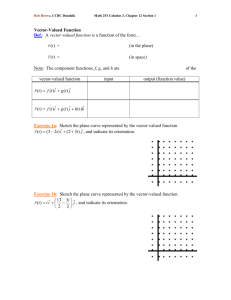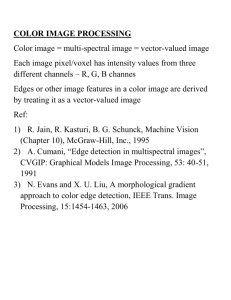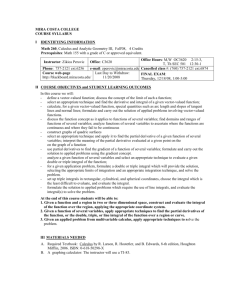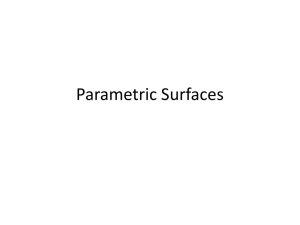Vector-Valued Functions
advertisement
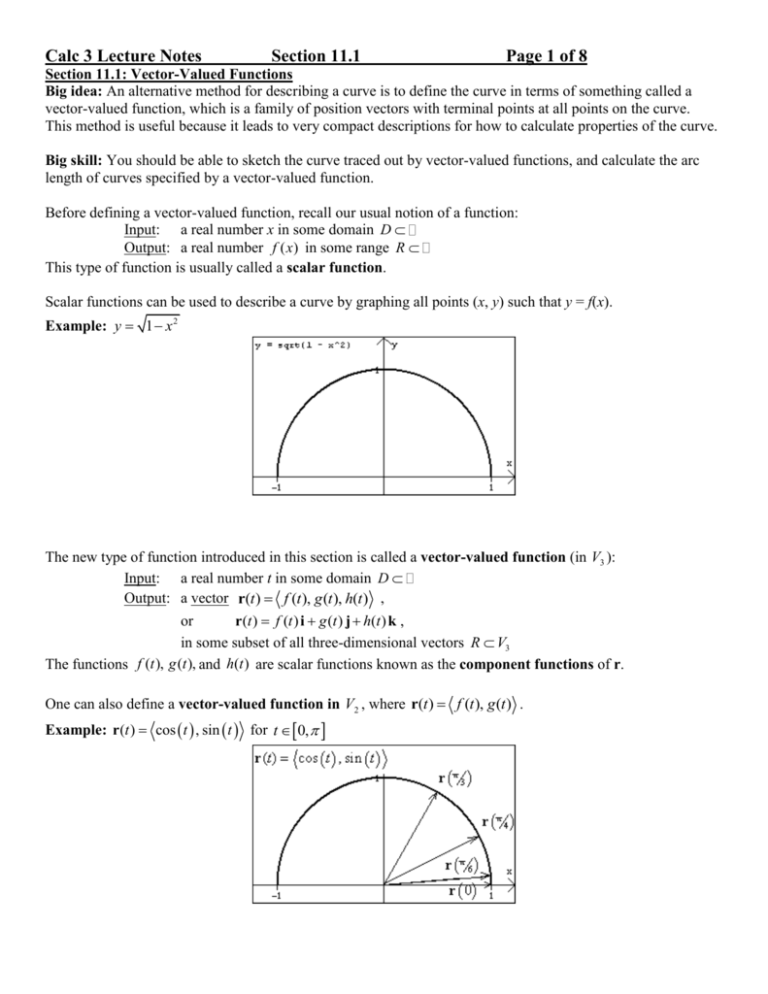
Calc 3 Lecture Notes Section 11.1 Page 1 of 8 Section 11.1: Vector-Valued Functions Big idea: An alternative method for describing a curve is to define the curve in terms of something called a vector-valued function, which is a family of position vectors with terminal points at all points on the curve. This method is useful because it leads to very compact descriptions for how to calculate properties of the curve. Big skill: You should be able to sketch the curve traced out by vector-valued functions, and calculate the arc length of curves specified by a vector-valued function. Before defining a vector-valued function, recall our usual notion of a function: Input: a real number x in some domain D Output: a real number f (x) in some range R This type of function is usually called a scalar function. Scalar functions can be used to describe a curve by graphing all points (x, y) such that y = f(x). Example: y 1 x 2 The new type of function introduced in this section is called a vector-valued function (in V3 ): Input: a real number t in some domain D Output: a vector r(t ) f (t ), g (t ), h(t ) , r (t ) f (t ) i g (t ) j h(t ) k , or in some subset of all three-dimensional vectors R V3 The functions f (t ), g (t ), and h(t ) are scalar functions known as the component functions of r. One can also define a vector-valued function in V2 , where r(t ) f (t ), g (t ) . Example: r (t ) cos t , sin t for t 0, Calc 3 Lecture Notes Section 11.1 Page 2 of 8 Definition 1.1: Vector-Valued Function A vector-valued function r(t) is a mapping from its domain D to its range R V3 , so that for each t in D, r(t) = v for exactly one v V3. We can write a vector-valued function as r(t) = f(t)i + g(t)j + h(t)k, for some scalar functions f, g, and h (called the components of r). The vector function r(t) thus corresponds to a family of vectors, one for each value of t in the domain. We usually use the letter t (rather than x) to denote the independent variable because in most applications, t will represent time. Our most common application will be to use a vector function to describe the position of an object moving in 2D or 3D space. Recall that a position vector is one that is drawn with its initial point at the origin. The terminal point of r(t) will correspond to the object’s position at time t. As t increases, the vector function will trace out some curve. r t f t , g t , h t Thus, the vector function corresponds to the set of parametric equations x f (t ), y g (t ), z h(t ), with the subtle distinction that the parametric equations describe points on the curve itself, while the vector function describes a family of position vectors whose terminal points trace out the curve. Practice: The 2D vector-valued functions below are frequently used in many applications. 1. 2D vector-valued functions that trace out a line. a. Sketch r t 4t 1, 2t 5 and find the Cartesian equation that describes the curve it traces out. b. Find the Cartesian equation for the curve traced out by any linear vector-valued function of the form r t k1t c1 , k2t c2 . Calc 3 Lecture Notes Section 11.1 Page 3 of 8 2. 2D vector-valued functions that trace out a parabola. 1 a. Sketch r t t 2 2, t 1 and find the Cartesian equation that describes the curve it traces 2 out. b. Find the Cartesian equation for the curve traced out by any linear vector-valued function of the form r t k1t c1 , at 2 bt c or r t at 2 bt c, k1t c1 . 3. 2D vector-valued functions that trace out an ellipse. a. Sketch r t 3cos t , 2sin t and find the Cartesian equation that describes the curve it traces out. b. Find the Cartesian equation for the curve traced out by any linear vector-valued function of the form r t a cos t , b sin t . Calc 3 Lecture Notes Section 11.1 Page 4 of 8 4. 2D vector-valued functions that trace out a hyperbola. a. Sketch r t 5cosh t , 2sinh t and find the Cartesian equation that describes the curve it traces out. b. Find the Cartesian equation for the curve traced out by any linear vector-valued function of the form r t a cosh t , b sinh t or r t a sinh t , b cosh t . Practice: The 3D vector-valued functions below are frequently used in many applications. 5. 3D vector-valued functions that trace out a line. a. Sketch r t 1 t , 3t , t . b. State a general form for a 3D vector-valued function that traces out a line. Calc 3 Lecture Notes Section 11.1 Page 5 of 8 6. 3D vector-valued functions that trace out an elliptical helix. a. Sketch r t cos t i 2sin t j t k . b. State a general form for a 3D vector-valued function that traces out a helix that “lives” on the x2 y 2 cylindrical surface 2 2 1 and completes one full turn over a vertical distance of H. a b Calc 3 Lecture Notes Section 11.1 Page 6 of 8 Practice: Use graphing software to graph the curves traced out by the following vector-valued functions. 7. r t cos t , ln t ,sin t 8. r t t cos t ,sin t , t 9. r t 3sin 2t , t , t 10. r t 5sin 3 t ,3cos3 t , t Calc 3 Lecture Notes Section 11.1 Page 7 of 8 3 Arc Length in Arc length of a curve defined traditionally by y = f(x) on an interval x [a, b] (see section 5.4): b s 1 f x dx 2 a Arc length of a curve defined by parametrically by x = f(t) and y = g(t)on an interval t [a, b] (see section 9.3): b s f t g t dt 2 2 a New: Arc length of a curve defined by a vector-valued function r(t) = f(t)i + g(t)j + h(t)k, on an interval t [a, b]: b s f t g t h t dt 2 2 2 a Note that this integrand should remind you of the formula for computing the length of a diagonal of a 3D box: c length 2 width 2 height 2 It is usually impossible to find the antiderivative of the integrand exactly, so we’ll usually have to settle for an approximate numerical answer to our arc length calculations. Practice: 11. Compute the arc length for the curve traced out by the vector-valued function r t cos t i sin t j t k for 0 t 2. Calc 3 Lecture Notes Section 11.1 Page 8 of 8 12. Compute the arc length for the curve traced out by the vector-valued function r t 5sin 3 t ,3cos3 t , t for 0 t 2. Parametric equations for an intersection of surfaces: Eliminate one variable (if necessary). Set another variable to the independent parameter t. Write all variables in terms of t. Practice: 13. Find the arc length for the curve determined by the intersection of the cylinders x 2 y 2 9 and y 2 z 2 1.
